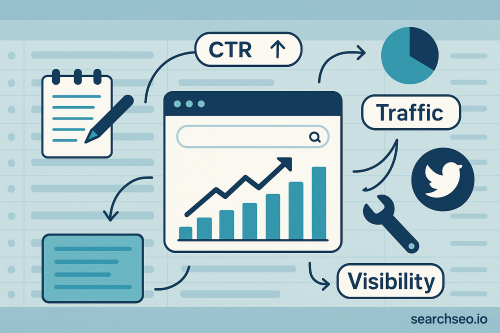Being visible online is not about luck, it is about strategy. An SEO strategy is the blueprint that turns searchers into visitors, clicks into trust, and content into results. It is not just about ranking higher, it is about getting noticed, earning attention, and making users choose your brand. The stronger your strategy, the more every click works in your favor, boosting relevance, authority, and growth.

How to create an SEO strategy
Step 1: Define your goals and business outcomes
A strong SEO strategy starts with clear business goals, not vague ambitions like reach number one. Think about outcomes that matter to your team such as brand visibility, qualified traffic, product signups or demo requests. Backlinko and Semrush both highlight that the most effective SEO plans are tied to revenue, growth or brand visibility rather than vanity ranking metrics.
CTR fits naturally into this approach. If a page has strong impressions but weak clicks, CTR becomes a practical lever for improving traffic without changing your ranking position.
Step 2: Audience and keyword research
Modern keyword research is not about guessing phrases. HubSpot recommends building your strategy around topics first, then diving into the specific terms your audience uses. This approach helps you uncover patterns in user intent.
- Awareness searches reveal early research.
- Consideration searches compare options.
- Decision searches show buying intent.
As you explore these patterns, look for keywords that generate a lot of impressions but attract few clicks. These gaps often represent pages that can grow significantly with better titles, meta descriptions or SERP enhancements.
Step 3: Map content and keywords to create your SEO content strategy
Once you understand your audience and their search patterns, connect keywords to the content you plan to publish. Topic clusters work especially well for this. You create one comprehensive page that covers a theme and then build supporting articles that explore related questions. This structure is highly recommended because it helps both users and search engines understand your expertise.
Within this content map, add opportunities to raise CTR. Sharper titles, clearer descriptions, and schema markup can make your results stand out and attract more visitors even if ranking stays constant.
Step 4: Technical, on page and off page fundamentals
No SEO strategy works without a strong foundation. Keep your site fast and indexable. Make sure your pages are mobile friendly. Use structured data where it makes sense, and give search engines a clear hierarchy to follow. On page elements such as headings, internal links and descriptive content all reinforce this structure.
Off page signals matter as well. Links, mentions and brand recognition all show search engines that people trust your content. When you combine this with an optimized SERP presence, you set yourself up for higher click through and stronger long term growth.
Step 5: Backlinks, mentions and authority building
Authority is a major ranking factor, but it is also a brand awareness driver. A thoughtful link building plan might include guest contributions, digital PR, partnerships or resources that others naturally want to reference. As your authority increases, all of your pages benefit.
Higher CTR works alongside authority. When users choose your page more often, it reinforces the idea that your result is the relevant one. This combination helps your entire keyword portfolio lift over time.
Step 6: Measure success and refine your strategy
The best SEO strategies evolve. Track impressions, clicks, CTR, conversions, brand search volume and the behavior on your key pages. These metrics give you a clear picture of what is working and what needs refinement.
CTR should be one of your ongoing focus areas. Titles, descriptions and snippet formats can all be tested and improved. Small changes often lead to noticeable engagement lifts, especially for high impression pages. Over time, these adjustments help you create a more resilient and predictable SEO marketing strategy.
SEO strategy checklist
For a quick reference, your strategy should include:
• Clear goals tied to business outcomes
• Audience and keyword research
• Intent based content planning
• A topic cluster content structure
• Strong technical and on page foundations
• A plan for earning authority and mentions
• Consistent optimization for click through
• A tracking system for impressions, clicks, CTR and conversions
• Regular review and improvement cycles
CTR manipulation as an advanced lever in your SEO strategy
CTR manipulation is simply the practice of improving the number of users who click your result. More than fifty eight percent of searches now end without a click, which means winning the click is more competitive than ever.
Practical CTR improvements often include rewriting titles to highlight value, improving meta descriptions to match search intent, adding structured data for rich results, or optimizing pages to qualify for People Also Ask or featured snippet opportunities. Even a small lift can produce meaningful traffic growth.
A simple example illustrates this well. Imagine a page with ten thousand impressions and a one percent CTR. That means it receives one hundred visitors. If you improve the title and meta and raise CTR to three percent, traffic triples without changing ranking at all. These improvements stack quickly across an entire site.
CTR belongs in every SEO strategy because it turns visibility into action.
Common mistakes to avoid in your SEO strategy
The most common errors usually come from skipping the fundamentals. Teams chase rankings without aligning goals to business outcomes. They overlook user intent or publish content without a real strategy behind it. Others forget to optimize for click through, neglect mobile experience, or fail to measure CTR in the first place.
Avoiding these mistakes helps you build a more stable and predictable SEO program.
Ready to take your SEO strategy further
SearchSEO helps you put your SEO strategy into action by improving CTR. It uses natural residential IP addresses and real browsers to deliver trustworthy signals, and the support guide explains how projects, targeting and validation work behind the scenes .
Getting started is simple. Create your account, set up a project, add your keywords and track clicks. As you learn what works, you can refine your strategy and scale the results. Your next step is simple. Start your free trial and see how quickly your strategy can evolve.


.svg)

.svg)
%201.png)








.svg)